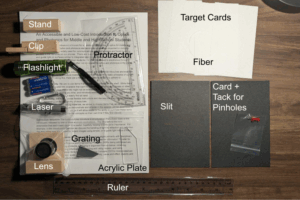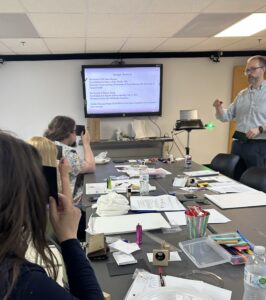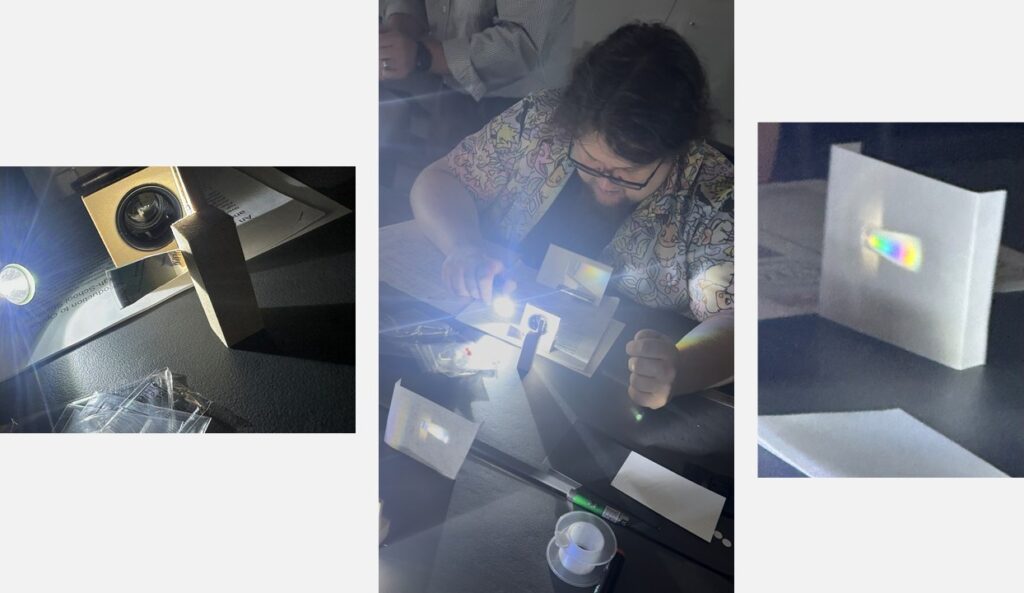On July 14th, QNN group co-leader Dr. P. “Donnie” Keathley led a successful hands-on optics workshop for middle and high school teachers in Eastern Kentucky. This is hopefully the first of many outreach workshops in the coming years. With coordination from the local organization Kentucky Valley Educational Cooperative (KVEC), Dr. Keathley designed and led a workshop for teaching a sample optics curriculum for educators to take into and adapt for their classrooms.

An example of a basic kit of materials used for all for the experiments.
In this one-day workshop for four educators, Dr. Keathley modeled a curriculum covering ray optics and waves, with hands-on experiments on imaging, fiber optics, and spectroscopy which involved low-cost and non-specialized materials. To the right is one of the experimental material kits given to the teachers. He taught them as if they were the students, handing out textbook-like material which included the how-to on the experiment. He also discussed how the curriculum could be used, including breaking points to simplify or extend the material.

Teachers testing an experiment on the wave pattern of light using black index cards with two pin-holes while Dr. Keathley explains
As part of the proposal for his NSF CAREER award Dr. Keathley included an optics outreach effort in Eastern Kentucky. The NSF has a long-term interest in broadening the pool of future scientists. But as to why work with Eastern Kentucky in particular? The Appalachia region, including Eastern Kentucky, have historically low STEM engagement and opportunity. Additionally, when researching outreach efforts, Donnie found many more efforts targeting urban areas, and thus decided to take the opportunity to focus his outreach on more rural environments. He was able to connect with KVEC before submitting the proposal, and they were interested in working with him.
As a final draw to selecting this area, Dr. Keathley grew up in the region and recalls the relative sparsity of opportunities to engage with STEM compared to areas like the Boston metro area with large science museums, research universities, and STEM industry.
Throughout the year-long design process, KVEC’s input on community needs and connections to educators were crucial. While Dr. Keathley’s original idea focused on a hand-on optics workshop for the middle and high school students, KVEC’s experience helped reframe it to focus on teaching the teachers for a larger and more enduring impact. As Dr. Keathley notes, the impact of an outreach event can be “frustratingly nebulous and difficult to define rigorously.” However, by focusing on educators, the impact of one workshop can not only endure over multiple years but also touch hundreds of students. If each of the four teachers were able to incorporate even one new experiment and unit from the workshop, about 425 students would benefit in the first year alone. And the community outreach is not planned to end after this one event. KVEC and Donnie plan to follow up with these four teachers with a zoom call in December on how and if they have been able to incorporate it into their curriculum. Also, the initial planning for a second workshop next summer is already underway!

An educator at a workshop performing an experiment on making a camera image of a very clear example of a diffraction grating.
For additional photos from the event, visit KVEC’s flicker account.